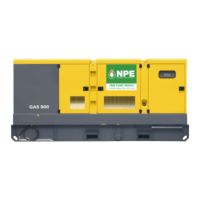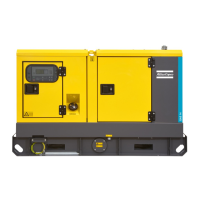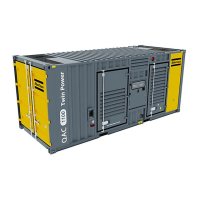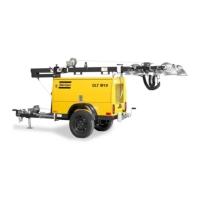Instruction manual
2954 2100 01 29
The voltage drop across a cable can be determined as follows:
e = Voltage drop (V)
I = Rated current (A)
L = Length of conductors (m)
R = Resistance (Ω/km to VDE 0102)
X = Reactance (Ω/km to VDE 0102)
3.2.3 Connecting the load
Site distribution panel
If outlet sockets are required, they must be mounted on a site
distribution panel supplied from the terminal board of the generator
and in compliance with local regulations for power installations on
building sites.
Protection
– Check whether frequency, voltage and current comply with the
ratings of the generator.
– Provide for the load cable, without excessive length, and lay it out
in a safe way without forming coils.
– Open the door of the control and indicator panel and the transparent
door in front of the terminal board X1.1.
– Provide the wire ends with cable lugs suited for the cable terminals.
– Loosen the cable clamp and push the wire ends of the load cable
through the orifice and clamp.
– Connect the wires to the proper terminals (L1, L2, L3, N and PE) of
X1 and tighten the bolts securely.
– Tighten the cable clamp.
– Close the transparent door in front of X1.1.
3.3 Before starting
– With the generator standing level, check the engine oil level and top
up if necessary. The oil level must be near to, but not exceed the
high mark on the engine oil level dipstick.
– Check the coolant level in the expansion tank of the engine cooling
system. The coolant level must be near to the FULL mark. Add
coolant if necessary.
– Drain any coolant and sediment from the fuel pre-filter. Check the
fuel level and top up if necessary. It is recommended to fill the tank
after the day’s operation to prevent coolantdamp in a nearly empty
tank from condensing.
– Check the vacuum indicator of the air filter. If the red part shows
completely, replace the filter element.
– Press the vacuator valve of the air filter to remove dust.
– Check the generator for leakage, tightness of wire terminals, etc.
Correct if necessary.
– Check that fuse F4 is not activated and that the emergency stop is in
the “OUT” position.
– Check that the load is switched off.
– Check that circuit breaker Q1 is switched off.
– Check that the earth fault protection (N13) has not tripped (reset if
necessary).
3.4 Operating Qc1001™
3.4.1 Starting Qc1001™
To start up the unit locally, proceed as follows:
– Switch on the battery switch.
– Switch off circuit breaker Q1. This is not necessary when a plant
contactor is installed between Q1 and the load.
– Put the starter switch in position . The unit starts a preheating
cycle which takes 12 seconds.
– After the preheating period, the unit will start. The starting attempt
will take maximum 12 seconds.
– Switch on circuit breaker Q1 in case no contactor is installed.
To start up the unit from a remote location,
proceed as follows:
– Put the starter switch in position .
– Switch on circuit breaker Q1.
– Put the remote start/stop switch in position start. The unit starts a
preheating cycle which takes 12 seconds.
– After the preheating period, the unit will start. The starting attempt
will take maximum 12 seconds.
For safety reasons, it is necessary to provide an iso-
lating switch or circuit breaker in each load circuit.
Local legislation may impose the use of isolating
devices which can be locked.
e
3IL R ϕcos⋅ X ϕsin⋅+()⋅⋅ ⋅
1000
------------------------------------------------------------------------------
=
!
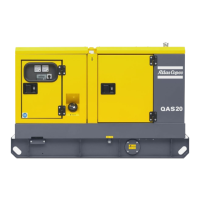
